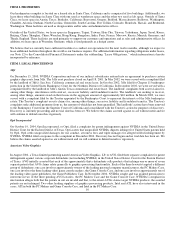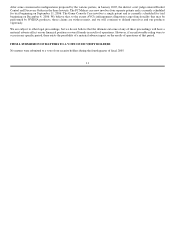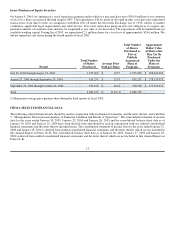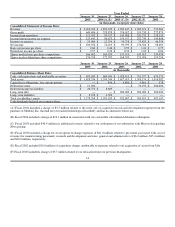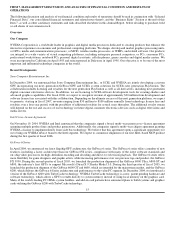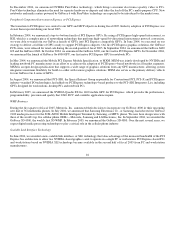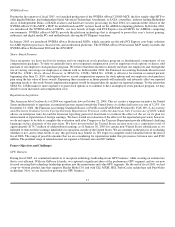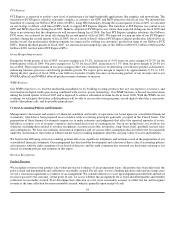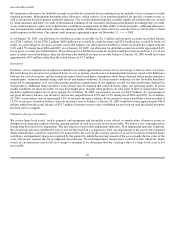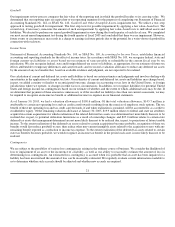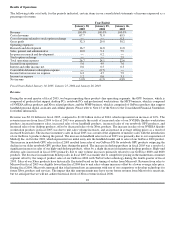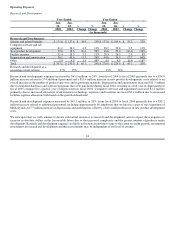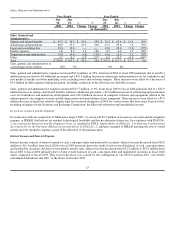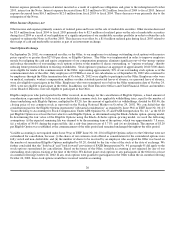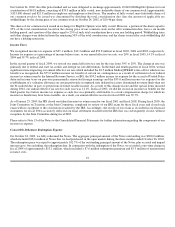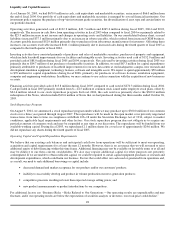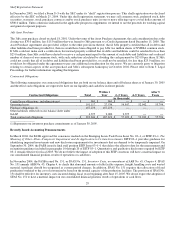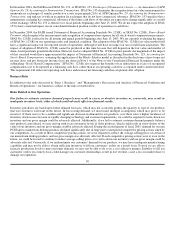NVIDIA 2005 Annual Report Download - page 26
Download and view the complete annual report
Please find page 26 of the 2005 NVIDIA annual report below. You can navigate through the pages in the report by either clicking on the pages listed below, or by using the keyword search tool below to find specific information within the annual report.
Accounts Receivable
We maintain an allowance for doubtful accounts receivable for estimated losses resulting from the inability of our customers to make
required payments. Management determines this allowance, which consists of an amount identified for specific customer issues as
well as an amount based on general estimated exposure. Our overall estimated exposure excludes significant amounts that are covered
by credit insurance and letters of credit. If the financial condition of our customers, the financial institutions providing letters of credit,
or our credit insurance carrier were to deteriorate, resulting in an impairment of their ability to make payments, additional allowances
may be required that could adversely affect our operating results. Furthermore, there can be no assurance that we will be able to obtain
credit insurance in the future. Our current credit insurance agreement expires on December 31, −−−−−2005.
As of January 30, 2005, our allowance for doubtful accounts receivable was $1.5 million and our gross accounts receivable balance
was $336.2 million. Of the $336.2 million, $68.0 million was covered by credit insurance and $22.4 million was covered by letters of
credit. As a percentage of our gross accounts receivable balance, our allowance for doubtful accounts receivable has ranged between
0.4% and 1.5% during fiscal 2004 and 2005. As of January 30, 2005, our allowance for doubtful accounts receivable represented 0.4%
of our gross accounts receivable balance. If our allowance for doubtful accounts receivable would have been recorded at 1.5% of our
gross accounts receivable balance, then our allowance for doubtful accounts receivable balance at January 30, 2005 would have been
approximately $4.9 million, rather than the actual balance of $1.5 million.
Inventories
Inventory cost is computed on an adjusted standard basis (which approximates actual cost on an average or first−in, first−out basis).
We write down our inventory for estimated lower of cost or market, obsolescence or unmarketable inventory equal to the difference
between the cost of inventory and the estimated market value based upon assumptions about future demand, future product purchase
commitments, estimated manufacturing yield levels and market conditions. If actual market conditions are less favorable than those
projected by management, or if our future product purchase commitments to our suppliers exceed our forecasted future demand for
such products, additional future inventory write−downs may be required that could adversely affect our operating results. If actual
market conditions are more favorable, we may have higher gross margins when products are sold. Sales to date of such products have
not had a significant impact on our gross margin. As of January 30, 2005, our inventory reserve was $33.7 million. As a percentage of
our gross inventory balance, our inventory reserve has ranged between 8.8% and 13.4% during fiscal 2004 and 2005. As of January
30, 2005, our inventory reserve represented 9.6% of our gross inventory balance. If our inventory reserve would have been recorded at
13.4% of our gross inventory balance, then our inventory reserve balance at January 30, 2005 would have been approximately $46.8
million, rather than the actual balance of $33.7 million. Inventory reserves once established are not reversed until the related inventory
has been sold or scrapped.
Valuation of Long−lived Assets
We review long−lived assets, such as property and equipment and intangible assets subject to amortization, whenever events or
changes in circumstances indicate that the carrying amount of such assets may not be recoverable. We utilize a two−step approach to
testing long−lived assets for impairment. The first step tests for possible impairment indicators. If an impairment indicator is present,
the second step measures whether the asset is recoverable based on a comparison of the carrying amount of the asset to the estimated
undiscounted future cash flows expected to be generated by the asset. If the carrying amount of an asset exceeds its estimated future
cash flows, an impairment charge is recognized by the amount by which the carrying amount of the asset exceeds the fair value of the
asset. Our review requires the use of judgment and estimates. No such impairment charges have occurred to date. However, future
events or circumstances may result in a charge to earnings if we determine that the carrying value of a long−lived asset is not
recoverable.
20


